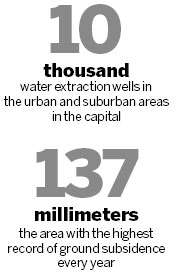Beijing urban areas to halt underground water extraction
Updated: 2012-02-28 08:20
By Xu Wei (China Daily)
|
|||||||||||
BEIJING - Underground water extraction will be halted by 2014 in the urban areas of Beijing as authorities seek to prevent further land subsidence, or sinking, in the city.
The 800 water extraction wells within the fifth ring road areas in 2012 will be closed as part of an effort to conserve underground water, Yu Yaping, a publicity official at the Beijing Water Authority, said.
|
 |
The North-South Water Diversion Project will bring 1 billion cubic meters of water supply to Beijing in 2014. The water could satisfy one-third of the total water demand in Beijing, which was 3.6 billion cubic meters in 2011.
The water diversion project is designed to take water from China's longest river, the Yangtze River, to feed the drought-prone areas in the north, including Beijing and Tianjin.
The water from the diversion project would also help to cut underground water extraction in the capital by half, Yu said, as underground water now accounts for two-thirds of the water supply in Beijing.
Yu denied reports that the city will take measures to replenish groundwater in the near future.
Beijing has more than 10,000 water extraction wells in the urban and suburban areas. Yu said the wells in the suburban areas will be preserved, but the authority will make sure that no more water extraction wells will be opened in future.
Statistics provided by the authority show that the past 10 years have seen the water table of the capital dropping from 12 meters to 24 meters due to overextraction of underground water, which is a major factor causing land subsidence in Beijing.
Land subsidence has caught the attention of the municipal government of Beijing in recent years and authorities have established seven monitoring stations and 117 GPS monitoring points as part of an early warning system.
According to a report conducted by Beijing Institute of Hydrogeology and Engineering Geology in 2010, land subsidence in Beijing has sped up since the 1950s, due to the large amount of groundwater extraction. As of 2009, the area with the highest record of ground subsidence reached 137.51 mms every year.
Land subsidence in certain areas of Changping district and Chaoyang district has exceeded 900 mms in total, according to the report.
Numerous cases of fracturing of water and gas pipes and road sinking occurred at land subsidence areas in recent years, the report said. It warned of a potential threat to the construction of new subway lines posed by subsidence.
Meanwhile, experts also warned of the possible side effects of a rising underground water level.
Wang Jian, a former water expert from the Beijing environmental protection bureau, said rising underground water could also cause potential damage because the ground level will rise accordingly.
"There might be water in the subway tunnels on land that used to be dry and the underground pipes could also be threatened," Wang said.
On Feb 21, the State Council approved a national set of guidelines to prevent land subsidence during the 2011-20 period, which include a nationwide survey on land subsidence, the establishment of monitoring networks in affected areas and increased control over underground water-pumping.
Land subsidence has plagued more than 50 cities in China, such as those in the Yangtze River Delta and North China. Shanghai is among the most severely affected cities, according to the guidelines.
Today's Top News
President Xi confident in recovery from quake
H7N9 update: 104 cases, 21 deaths
Telecom workers restore links
Coal mine blast kills 18 in Jilin
Intl scholarship puts China on the map
More bird flu patients discharged
Gold loses sheen, but still a safe bet
US 'turns blind eye to human rights'
Hot Topics
Lunar probe , China growth forecasts, Emission rules get tougher, China seen through 'colored lens', International board,
Editor's Picks

|

|

|

|

|

|





